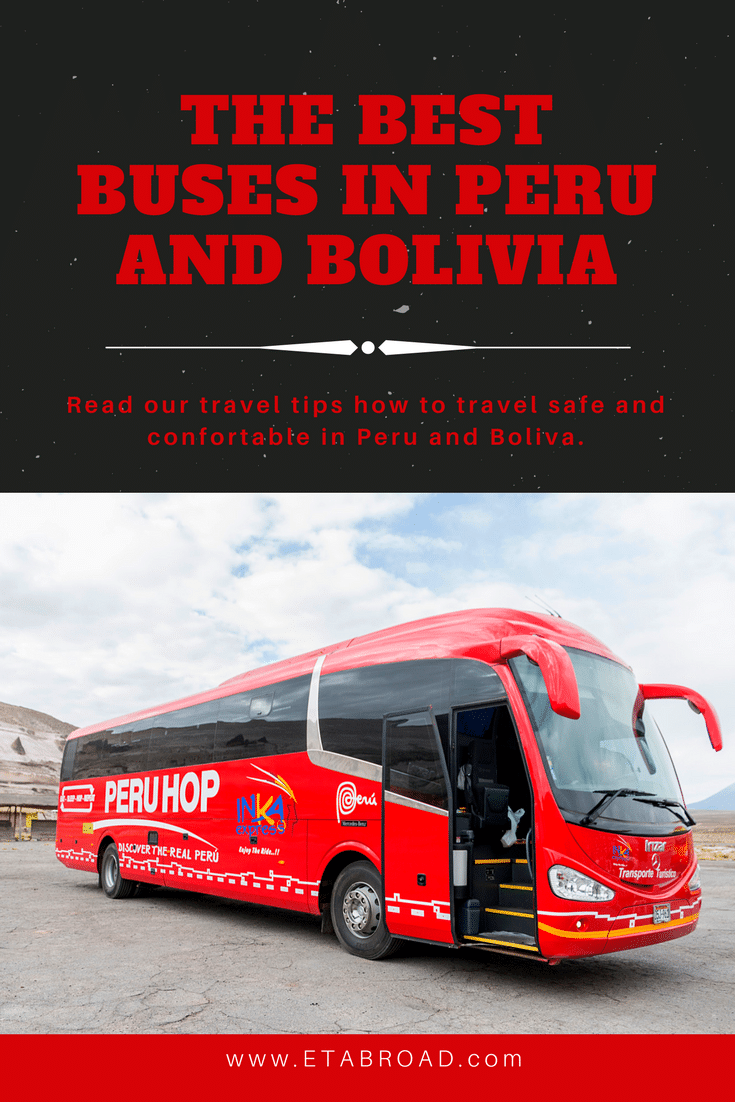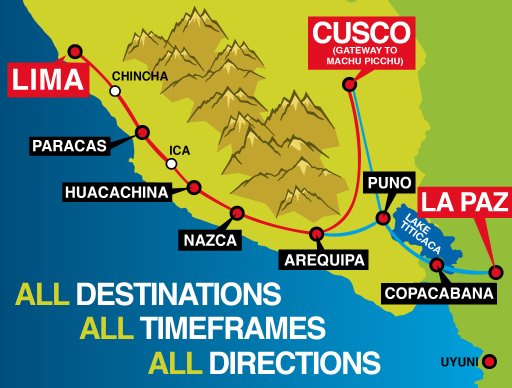Bus travel in South America can occasionally be quite adventurous. Fortunately, we came across Peru Hop / Bolivia Hop. We also travelled on normal buses in Peru and Bolivia and had the opportunity to try out travelling with Peru Hop, so we were able to compare the differences in the services offered. And those were huge.
What is Peru Hop / Bolivia Hop?
Peru Hop is a company providing absolutely unique transport services in Peru and Bolivia (in Bolivia the company is known as Bolivia Hop). These buses go around the most popular tourist cities according to a pre-set route. You can buy tickets from point A to point B and make stops at any place along the way for as long as you’d like. You have up to one year to use up your entire ticket! You are able to plan everything via their web interface. Any part of your itinerary can be changed at least 12 hours before departure. So it’s ideal for long time backpacking in South America as you can stay in any places as long you want. The company specializes in tourist services. This means that they stop at several interesting places along the road, so you won’t miss out on anything.
Peru Hop and Bolivia Hop Routes
The basic Peru Hop route leads from Lima to Cuzco (or vice versa) and the buses make several stops along the way. It’s only up to you – how much time you have and what you’d like to see. Bolivia Hop also provides the Cuzco – La Paz route, which is the one that we rode on. Of course, a combination of these routes is also possible, which is Lima – La Paz. You can use Peru Hop buses for the typical Two-weeks itinerary in Peru.
We recommend stopping in Puno on the way and go on a boat trip on Lake Titicaca and spend the night with locals.

The Advantages of Bolivia Hop
- The discount program offered by Peru Hop / Bolivia Hop always includes cheaper accommodation and tours in the cities where they have bus stops. Because they work with FindLocalTrips.com, they have altered their times of departures and arrivals so that you are able to try out everything.
- A local guide is always present on board and they speak excellent English. The guide will help you with anything you might need. They will take care of everything starting from your accommodation to just giving you a tip for a really good restaurant.
- Door-to-door service, which means that you don’t have to worry about taxis or finding out where do the buses run from etc. There is often no central bus station in Peruvian and Bolivian cities and individual bus companies have their own terminals. Because of this, a simple task of buying a ticket may take you a very long time. That did not happen with Bolivia Hop. They picked us up and took us directly to our hotel.
- Bolivia Hop buses always follow timetables, and that itself is almost a miracle in Peru and Bolivia, trust me.
- You’ll receive a warm blanket on board so you’ll sleep like a baby during the night rides and you are able to watch a movie in English. With other bus companies, you can only dream about that, because everything they have is in Spanish.
- Peru Hop / Bolivia Hop buses strictly adhere to their timetables and they only stop during long drives for breakfast etc. Other companies stop very irregularly and unpredictably almost anywhere so the journey may be extended disproportionately.
Do not miss – List of 8 places you must visit in Bolivia
The Disadvantages of Bolivia Hop
- The first point is, of course, the higher cost of the services provided by Bolivia / Peru Hop. This, however, is due to the range and uniqueness of their services. It’s up to everybody to think about whether they want to pay more for safety, simplicity, and precision.
- It wasn’t possible to be picked up from a hotel in Cuzco. But that’s understandable, especially when you see the local transport and how narrow the streets of Cuzco are. Peru Hop / Bolivia Hop have their own terminal there and we had no problems getting there with Uber.
- We had the opportunity to travel on both the new red buses of Peru Hop and the older vehicles. Sometimes we were slightly confused about whether it was the right bus, but all the employees had clearly visible signs of the company, so we never made a mistake.
- The thing that disappointed us the most was that the bus routes ended in La Paz. To get further, we had to travel on different buses, so we had to travel around Bolivia using local transport. Only when were we stuck in traffic in a taxi and then nervously ran around the La Paz bus terminal, did we start to fully appreciate the services of Bolivia Hop. We believe that in near future the company will be able to stretch their bus routes all the way to the city of Uyuni.
Crossing Peru – Bolivia Border
The border crossing between Peru and Bolivia is a category by itself. When you open Lonely Planet or TripAdvisor, you’ll be immediately overwhelmed by information about what to keep in mind during the crossing. But with Bolivia Hop, you don’t have to worry about anything. Everything is perfectly organized and the crossing goes smoothly.
On the way to the border, our guide distributed the necessary paperwork among us and advised us on how to fill them out. He also repeated what should we expect and what would happen several times. After arriving at the border he recommended an exchange office and then introduced his colleague, who would be our guide after we crossed over to Bolivia. Then we all went to the Peruvian customs and we all got an exit stamp. When everyone from the bus legally left Peru, we crossed the border on foot. A bus was already waiting for us there. The Bolivian custom office was next, where some of us had to arrange for a visa, but our guide assisted them. Only after everyone has crossed the border successfully did our bus set out for the nearby town of Copacabana.
Contact
Email : info@peruhop.com
Websites: www.peruhop.com / www.boliviahop.com
Tripadvisor – PeruHop / Tripadvisor – BoliviaHop
Thanks to PeruHop for support during our visit to Peru. All our views are based on our own experience.
Liked this post? PIN IT FOR LATER!!











did they ask to see a yellow fever cert, no?
No, nobody wants to see cert, but I had it.